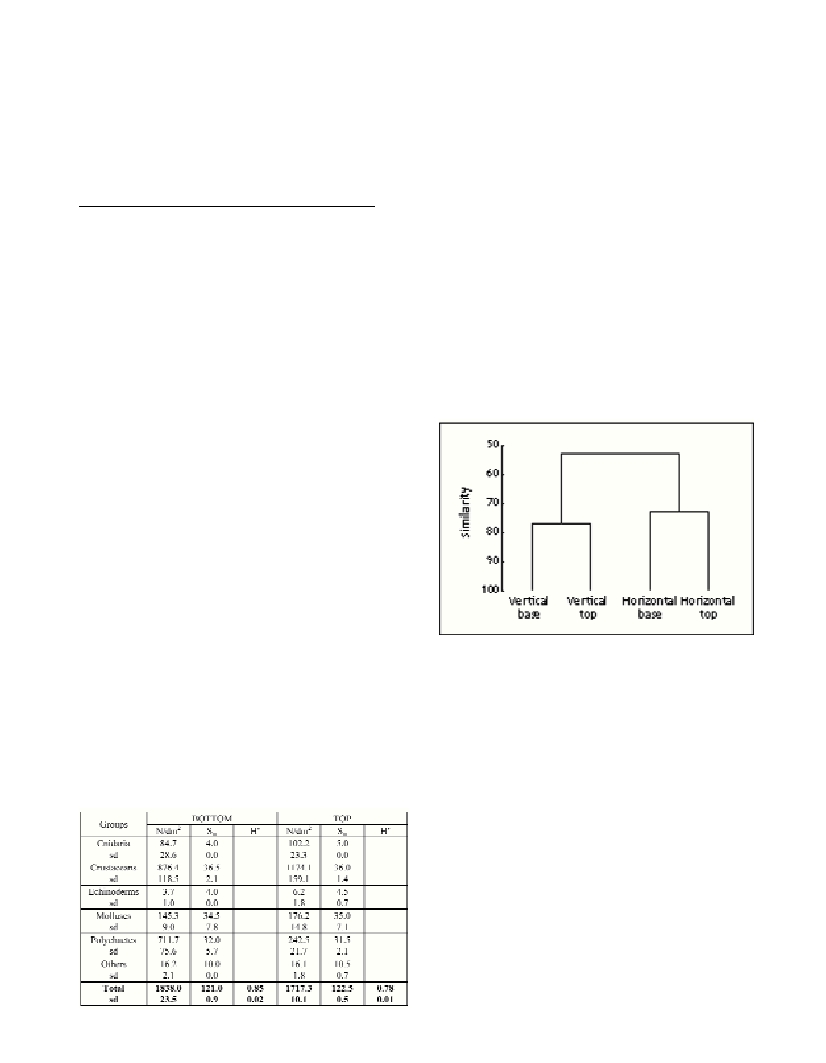BENTHIC COMMUNITY SETTLED ON AN ARTIFICIAL REEF IN THE WESTERN ADRIATIC SEA (ITALY)
Spagnolo A., Fabi G., Manoukian S.
*
, Panfili M.
CNR - Istituto di Scienze Marine - Sezione Pesca Marittima, Ancona, Italy - m.panfili@ismar.cnr.it
Abstract
Quantitative benthic samples were collected for two years from the horizontal and vertical walls of the concrete modules of Senigallia
artificial reef (northern Adriatic sea) to investigate the community settled after about ten years from reef deployment. The artificial
structures resulted colonised by a typical eutrophic water community dominated by filter-feeders and showed a different structure on
vertical and horizontal surfaces, due to some environmental factors such as siltation, wave motion and currents.
Key-words: Adriatic Sea, artificial reef, benthic community
Rapp. Comm. int. Mer Médit., 37,2004
552
Introduction
A general assumption of artificial reef research is that the
deployment of man-made structures on soft bottoms favours the
increase of original benthic communities complexity (1) due to the
development of hard-substrate species which could not find available
settlement surfaces before.
This statement was confirmed in the central Adriatic Sea, where
some studies carried out on the first artificial reef built on a soft-
bottom area evidenced that the submersion of man-made substrates
favoured the natural settlement of large banks of mussels (Mytilus
galloprovincialis) and oysters (Ostrea edulis, Crassostrea gigas)
which otherwise might be lost for the lack of suitable surfaces (2).
In order to obtain a more deep knowledge about the benthic
communities which colonize these artificial structures in respect to the
different depth levels and orientation, Senigallia artificial reef was
investigated after ten years from its deployment.
Material and Methods
Senigallia artificial reef is an open-sea area exposed to winds and
currents and affected by the Cesano river in?ow. It was deployed in
1987 at 1.5 nm offshore, on a sand-muddy bottom (12-13 m deep), far
from natural and artificial hard substrates and consists of 29 pyramids,
each made of five, 2m-side concrete blocks (4 at the basis and 1 at the
top; 3).
The benthic community settled both on basis and top blocks of the
pyramids was seasonally investigated, from April 1997 to March
1999. Standard areas (40x40 cm) were sampled with a suction-
sampler (horizontal surfaces) and scraping technique (vertical walls).
Two replicates for each surface were taken at each survey. Mean
abundance (N/dm
2
), mean species richness (S
m
) and Shannon-Weaver
diversity index (H’) were computed to quantify the role of the
different group species within the community. Similarity among
communities having different spatial settlement was evaluated using
Cluster analysis based on species abundance and biomass.
Results
In the overall, 56,855 individuals belonging to 179 taxa were
identified, 160 of which having a known link with a specific substrate
type. Epifauna settled on the artificial modules was dominated by
filter-feeders. Crustaceans (amphipods), polychaetes and molluscs
represented the most abundant groups everywhere (Table 1).
Crustaceans (i.e. Corophium acherusicum) were more numerous on
the top of pyramids, while polychaetes (Polydora ciliata) dominated
on the basis blocks.These groups were also the most important in
terms of S
m
without relevant differences between the two depth levels.
Very similar H’values were observed concerning the overall
communities settled at the two depth levels (Table 1).
Regardless of the block level, S
m
was higher on the horizontal
surfaces (130.0±11.3) than on the vertical ones (113.5±4.9) mainly
colonised by hard-substrate species, above all filter-feeders like
bivalves (M. galloprovincialis, O. edulis, C. gigas), hydroids (Obelia
dichotoma, Bougainvillia ramosa) and barnacles (i.e. Balanus
trigonus, Balanus perforatus), which represented 57% of the species
having a known link with a specific substrate. In addition to them,
deposit and suspension-feeders were found on the horizontal surfaces,
always covered by a thin layer of sand-muddy sediment. These were
typical soft-bottom organisms, e.g. gastropods and bivalves,
representing 51% of the species linked to a specific substrate. These
results were confirmed by Cluster analysis that grouped the surfaces
according to their orientation (Fig. 1).
Conclusions
About ten years from the deployment, the concrete blocks of
Senigallia artificial reef resulted colonised by a typical eutrophic
water community showing a different structure on vertical and
horizontal surfaces, due to theenvironmental conditions. On the
horizontal walls, where siltation caused by Cesano river in?ow and
bottom sediment resuspension due to wave motion are more intense,
the community was more heterogeneous and included a higher
number of species than the vertical ones, without consistent
differences among the depth levels.
Differently, the strong hydrodynamism plays a basic role in the
vertical surface community composition inducing a continuous turn-
over of suspended material. On the basis blocks such hydrodynamism
was less intense, favouring a higher settlement of sand species (i.e.
Sabellaria spinulosa) limiting the occurrence of hard-substrate filter-
feeders in respect to the top of the pyramids.
References
1-Bohnsack J.A., Johnson D.L., Ambrose R.F. 1991. Ecology of artificial
reef habitats and fishes. Pages 61-107, in: Seaman W.Jr., Sprague L.M.,
(Eds.), Artificial Habitats for Marine and Freshwater Fisheries. Academic
Press Inc., San Diego, California.
2-Bombace G., 1989. Artificial reefs in the Mediterranean sea. Bull. Mar.
Sci., 44 (2): 1023-1032.
3-Fabi G., Luccarini F., Panfili M., Solustri C., and Spagnolo A., 2002.
Effects of an artificial reef on the surrounding seabed community (central
Adriatic sea). ICES J. Mar. Sci., 59 (suppl.): 343-348.
Table 1. Biotic parameters describing the benthic community.
Fig. 1. Cluster analysis based on abundance and biomass of the species.

